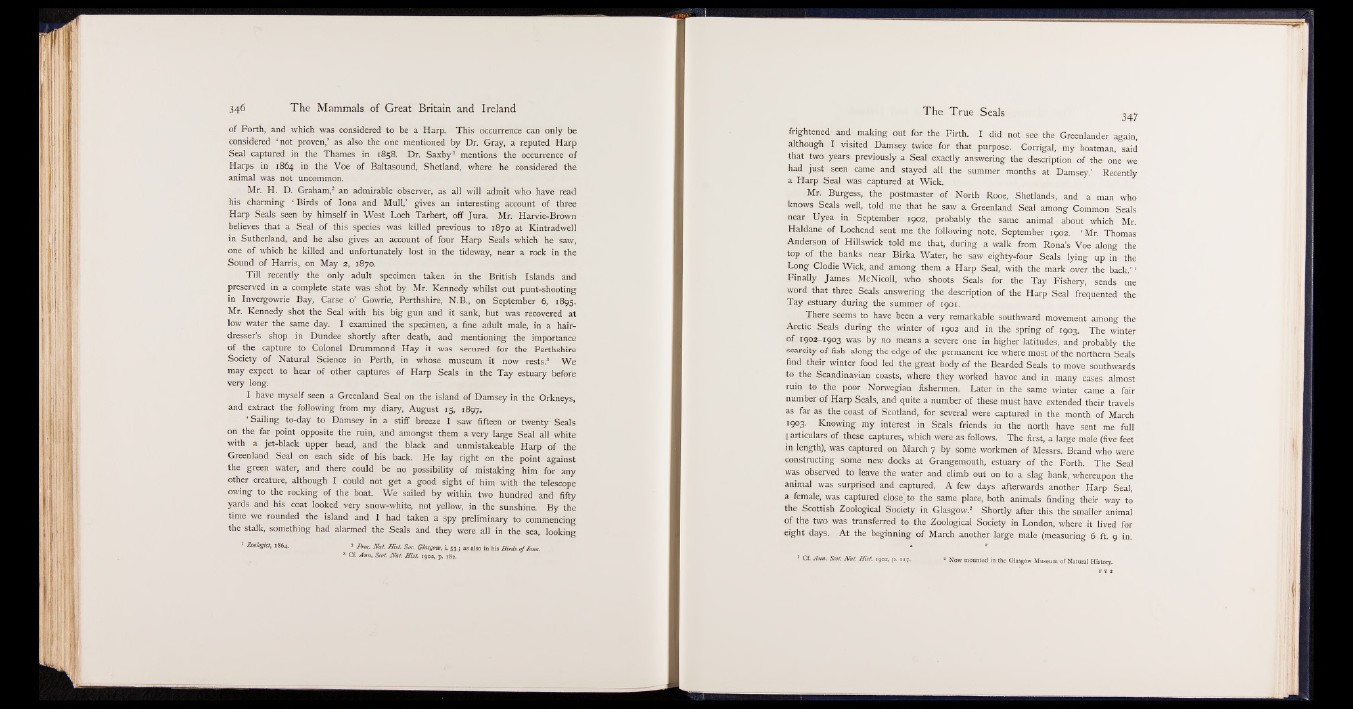
of Forth, and which was considered to be a Harp. This occurrence can only be
considered ‘ not proven,’ as also the one mentioned by Dr. Gray, a reputed Harp
Seal captured in the Thames in 1858. Dr. Saxby1 mentions the occurrence of
Harps in 1864 in the Voe of Baltasound, Shetland, where he considered the
animal was not uncommon.
Mr. H. D. Graham,2 an admirable observer, as all will admit who have read
his charming ‘ Birds of Iona and Mull,’ gives an interesting account of three
Harp Seals seen by himself in West Loch Tarbert, off Jura. Mr. Harvie-Brown
believes that a Seal of this species was killed previous to 1870 at Kintradwell
in Sutherland, and he. also gives an account of four Harp Seals which he saw,
one of which he killed and unfortunately lost in the tideway, near a rock in the
Sound of Harris, on May 2, 1870.
Till recently the only adult specimen taken in the British Islands and
preserved in a complete state was shot by Mr. Kennedy whilst out punt-shooting
in Invergowrie Bay, Carse.o’ Gowrie, Perthshire, N.B., on September 6, 1895.
Mr. Kennedy shot the Seal with his big gun and it sank, but was recovered at
low water the same day. I examined the specimen, a fine adult male, in a hairdresser’s
shop in Dundee shortly after death, and mentioning the importance
of the capture to Colonel Drummond Hay it was secured for the Perthshire
Society of Natural Science in Perth, in whose museum it now rests.8 We
may expect to hear of other captures of Harp Seals in the Tay estuary before
very long.
I have myself seen a Greenland Seal on the island of Damsey in the Orkneys,
and extract the following from my diary, August 15, 1897,
'Sailing to-day to Damsey in a stiff breeze I saw fifteen or twenty Seals
on the far point opposite the ruin, and amongst them a very large Seal all white
with a jet-black upper head, and the black and unmistakeable Harp of the
Greenland Seal on each side of his back. He lay right on the point against
the green water, and there could be no possibility of mistaking him for any
other creature, although I could not get-a good sight of him with the telescope
owing to the rocking of the boat. We sailed by within two hundred and fifty
yards and his coat looked very snow-white, not yellow, in the sunshine. By the
time we rounded the island and I had taken a spy preliminary to commencing
the stalk, something had alarmed the Seals find they were all in the sea, looking
1 Zoologist, 1864. a Pros. N a t Mist. Sot. Glasgow, i. 53; as also in his Birds o f Iona.
3 Cf. Ann, Scot. Nat. Hist. 1902, p. 182.
frightened and making out for the Firth. I did not see -the Greenlander again,
although I visited Damsey twice for that purpose. Corrigal, my boatman, said
that two years previously a Seal exactly answering the description of the one we
had just seen came and stayed all' the summer months at Damsey.’ Recently
a Harp Seal was captured at Wick.
Mr. Burgess, the postmaster, of North Rooe, Shetlands, and a man who
knows Seals well, told me that he saw a. Greenland Seal among Common Seals
near Uyea in September 1902, probably the same animal about which Mr.
Haldane of Lochend sent me the following note,- September 1902. ‘ Mr. Thomas
Anderson of Hillswick told me that, during a walk from Rona’s Voe along the
top of the banks near Birka Water, he saw eighty-four Seals lying up in the
Long Clodie Wick, and among them a Harp Seal, with the: mark over the back.’ 1
Finally James McNicoll, who shoots Seals for- the Tay Fishery, sends me
word that three Seals answering the description of the Harp Seal frequented the
Tay estuary during the summer of rgor.
There seems to have been a very remarkable southward movement among the
Arctic Seals during the winter of t902 and in the spring of rg o j The winter
of 1902-1903 was by no means a severe one in higher latitudes, and probably the
scarcity of fish along the edge of the permanent ice where most of the northern Seals
find their winter food led the great body of the Bearded Seals to move, southwards
to the Scandinavian coasts, where they worked havoc and in many cases almost
ruin to the poor Norwegian fishermen. Later in the same winter came a fair
number of Harp Seals, and- quite a number of these must have extended their travels
as far as the coast of Scotland, for several were captured in the month of March
1903. Knowing my interest in Seals friends in the north have sent me full
] articulars of these captures, which were as follows. The first, a large male (five feet
in length), was captured on March 7 by some workmen of mI b B Brand who were
constructing some new docks at Grangemouth, estuary of the Forth. The Seal
was observed to leave the water and climb out on to a slag bank, whereupon the
animal was surprised and captured. A few days afterwards another Harp Seal,
a female, was captured close) to the same place, both animals finding their way to
the Scottish Zoological Society in Glasgow.“ Shortly after this the smaller animal
of the two was transferred to the Zoological Society in London, where it lived for
eight days. At the beginning of March another large male (measuring 6 ft. 9 in.
Cf. Ann. Scot. Nat. Hist. 1902, p. 117. * Now mounted in the Glasgow Museum of Natural History.